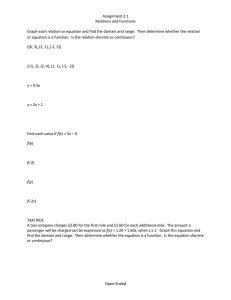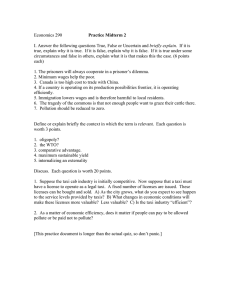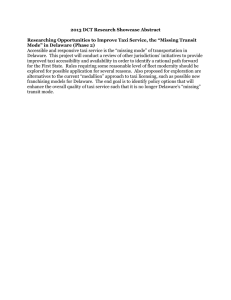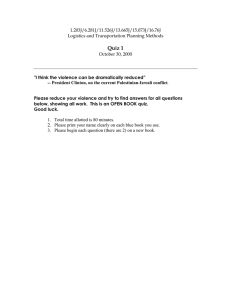Uploaded by
International Research Journal of Engineering and Technology (IRJET)
Taxi Ridesharing: Real-Time Recommendation System Analysis
advertisement
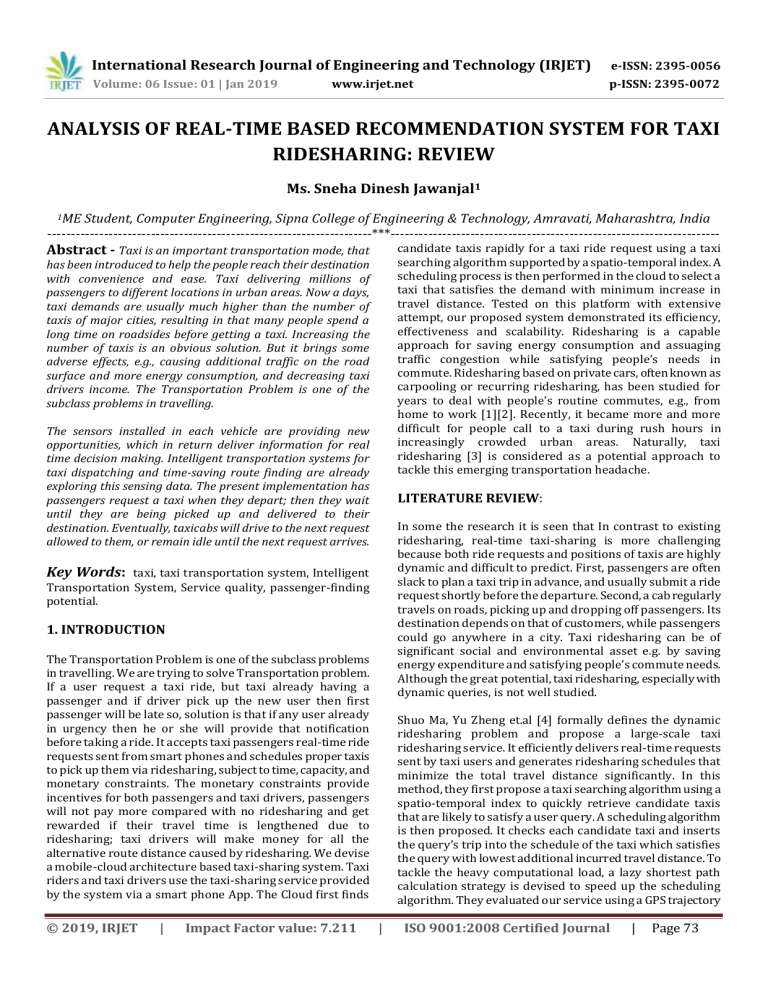
International Research Journal of Engineering and Technology (IRJET) e-ISSN: 2395-0056 Volume: 06 Issue: 01 | Jan 2019 p-ISSN: 2395-0072 www.irjet.net ANALYSIS OF REAL-TIME BASED RECOMMENDATION SYSTEM FOR TAXI RIDESHARING: REVIEW Ms. Sneha Dinesh Jawanjal1 1ME Student, Computer Engineering, Sipna College of Engineering & Technology, Amravati, Maharashtra, India ---------------------------------------------------------------------***---------------------------------------------------------------------- Abstract - Taxi is an important transportation mode, that candidate taxis rapidly for a taxi ride request using a taxi searching algorithm supported by a spatio-temporal index. A scheduling process is then performed in the cloud to select a taxi that satisfies the demand with minimum increase in travel distance. Tested on this platform with extensive attempt, our proposed system demonstrated its efficiency, effectiveness and scalability. Ridesharing is a capable approach for saving energy consumption and assuaging traffic congestion while satisfying people’s needs in commute. Ridesharing based on private cars, often known as carpooling or recurring ridesharing, has been studied for years to deal with people’s routine commutes, e.g., from home to work [1][2]. Recently, it became more and more difficult for people call to a taxi during rush hours in increasingly crowded urban areas. Naturally, taxi ridesharing [3] is considered as a potential approach to tackle this emerging transportation headache. has been introduced to help the people reach their destination with convenience and ease. Taxi delivering millions of passengers to different locations in urban areas. Now a days, taxi demands are usually much higher than the number of taxis of major cities, resulting in that many people spend a long time on roadsides before getting a taxi. Increasing the number of taxis is an obvious solution. But it brings some adverse effects, e.g., causing additional traffic on the road surface and more energy consumption, and decreasing taxi drivers income. The Transportation Problem is one of the subclass problems in travelling. The sensors installed in each vehicle are providing new opportunities, which in return deliver information for real time decision making. Intelligent transportation systems for taxi dispatching and time-saving route finding are already exploring this sensing data. The present implementation has passengers request a taxi when they depart; then they wait until they are being picked up and delivered to their destination. Eventually, taxicabs will drive to the next request allowed to them, or remain idle until the next request arrives. LITERATURE REVIEW: In some the research it is seen that In contrast to existing ridesharing, real-time taxi-sharing is more challenging because both ride requests and positions of taxis are highly dynamic and difficult to predict. First, passengers are often slack to plan a taxi trip in advance, and usually submit a ride request shortly before the departure. Second, a cab regularly travels on roads, picking up and dropping off passengers. Its destination depends on that of customers, while passengers could go anywhere in a city. Taxi ridesharing can be of significant social and environmental asset e.g. by saving energy expenditure and satisfying people’s commute needs. Although the great potential, taxi ridesharing, especially with dynamic queries, is not well studied. Key Words: taxi, taxi transportation system, Intelligent Transportation System, Service quality, passenger-finding potential. 1. INTRODUCTION The Transportation Problem is one of the subclass problems in travelling. We are trying to solve Transportation problem. If a user request a taxi ride, but taxi already having a passenger and if driver pick up the new user then first passenger will be late so, solution is that if any user already in urgency then he or she will provide that notification before taking a ride. It accepts taxi passengers real-time ride requests sent from smart phones and schedules proper taxis to pick up them via ridesharing, subject to time, capacity, and monetary constraints. The monetary constraints provide incentives for both passengers and taxi drivers, passengers will not pay more compared with no ridesharing and get rewarded if their travel time is lengthened due to ridesharing; taxi drivers will make money for all the alternative route distance caused by ridesharing. We devise a mobile-cloud architecture based taxi-sharing system. Taxi riders and taxi drivers use the taxi-sharing service provided by the system via a smart phone App. The Cloud first finds © 2019, IRJET | Impact Factor value: 7.211 Shuo Ma, Yu Zheng et.al [4] formally defines the dynamic ridesharing problem and propose a large-scale taxi ridesharing service. It efficiently delivers real-time requests sent by taxi users and generates ridesharing schedules that minimize the total travel distance significantly. In this method, they first propose a taxi searching algorithm using a spatio-temporal index to quickly retrieve candidate taxis that are likely to satisfy a user query. A scheduling algorithm is then proposed. It checks each candidate taxi and inserts the query’s trip into the schedule of the taxi which satisfies the query with lowest additional incurred travel distance. To tackle the heavy computational load, a lazy shortest path calculation strategy is devised to speed up the scheduling algorithm. They evaluated our service using a GPS trajectory | ISO 9001:2008 Certified Journal | Page 73 International Research Journal of Engineering and Technology (IRJET) e-ISSN: 2395-0056 Volume: 06 Issue: 01 | Jan 2019 p-ISSN: 2395-0072 www.irjet.net dataset generated by over 33,000 taxis during a period of 3 months. By learning the spatio-temporal distributions of real user queries from this dataset, they built an experimental platform that simulates user real behaviour in taking a taxi. Tested on this platform with extensive experiments, our approach demonstrated its efficiency, effectiveness, and scalability. For example, our proposed service serves 25% additional taxi users while saving 13% travel distance compared with no-ridesharing (when the ratio of the number of queries to that of taxis is 6). This paper proposes a practical large-scale taxi ridesharing service. They evaluated our service based on a GPS trajectory dataset generated by 33,000 taxis over 3 months, in which over 10 million queries were extracted. Based on this data, they implemented a T-Share prototype system. The experimental results demonstrated the effectiveness and efficiency of our system in serving dynamic queries. Firstly, our service can enhance the delivery capability of taxis in a city so as to satisfy the commute of more people. For instance, when the ratio between the number of taxi queries and the number of taxis is 6, our service served additional 25% taxi users than no ridesharing. Secondly, compared with the taxi system sending passengers individually, our ridesharing service saves the total travel distance of taxis when delivering passengers, e.g., our approach saved 13% travel distance with the same ratio mentioned above. Supposing a taxi consumes 8 liters of gasoline per 100km, and given the fact learned from the real trajectory dataset that the average travel distance of a taxi in a day (in Beijing) is about 480km, our service can save over 120 million liter of gasoline per year (worth about 160 million dollar). Thirdly, our service can also save the expense of a taxi user, while increasing the profit of a taxi driver. Using the pricing scheme designed (when =0.8), taxi drivers can increase their profit by 19% on average over no ridesharing. and the next passenger get-on location. They also adopted an ON-OFF model to estimate the expected fare for a trip started at a recommended location. A real world data set from CRAWDAD is used to classify the proposed system. A simulator is developed which simulates cruising behavior of taxies in the data set and one virtual taxi which based on our recommender system. Our simulation results indicate that although the statistics of historical data may be different from real-time passenger requests, our proposed recommender system is still effective on recommending better profitable cruising location. Android is a software stack for mobile devices that includes an operating system, middleware and key applications. To save the time for finding a taxicab and reduce unnecessary traffic flows as well as energy consumptions caused by cruising taxicabs, they proposed a taxi-passenger recommender system based on the pick-up behaviors of high-profit taxi drivers and the mobility patterns of passengers learned from a large number of taxi trajectories. They built the recommender system with a dataset generated by 12,000 taxicabs in a period of 110 days, and evaluated the system by extensive experiments including a series of in-the-field studies. as a result, the taxi recommender accurately predicts the time varying queue length at parking places and effectively provides the highprofit parking places; the passenger recommender successfully suggests the road 1 segment where users can easily find vacant taxis, e.g., the top-1 road segment recommended by our system considering day of the week and weather conditions matches the ground truth for all of the tested areas. In the future, we plan to adopt our recommender in the real world so as to further validate and improve the effectiveness and robustness of this system. P.-Y. Chen, J.-W. Liu, et al[6], said that Traffic congestion is a serious problem in urban areas of many countries due to the increasing amount of vehicles on surface streets and accompanies fuel-wasting and air-pollution. That problem can be alleviated by adopting a ride-sharing service. The main conception of ride-sharing service is to collect travelers whose travel destinations are nearby into one vehicle. We can reduce the amount of vehicles on surface streets and meantime save fuel. In this paper, the taxi-sharing service and propose a dynamic taxi-sharing system based on Intelligent Transportation Systems (ITS) technology. In the proposed system, we can immediately serve each random ride-sharing request and find a fuel-saving taxi for it. The simulation results show that our solution can correctly select a fuel-saving taxi for each ride-sharing request and outperform in responding time, the number of compared taxis, and fuel-saving while comparing with existing solution. Reshma Supugade, et al.[5] proposed new algorithm, they learn from-mentioned knowledge (represented by probabilities) from GPS trajectories of taxis. Then, feed the knowledge into a probabilistic model which estimates the profit of the candidate locations for a particular driver based on where and when the driver requests the recommendation. They build our system using historical trajectories generated by over 12,000 taxis during 110 days and validate the system with extensive evaluations including in-the-field user studies. In the literature, three aspects have been considered in different works to provide the identical objective, which are distance between the current location and the recommended location, waiting time for next passengers, and expected fare for the trip. In this paper, in addition to these factors, we consider one more factor based on drivers knowledge which is the most likely location to pick up passengers given the current passenger drop off location. A location-to-location graph model, referred to as OFF-ON model, is adopted to capture the relation between the passenger get-off location © 2019, IRJET | Impact Factor value: 7.211 De-Merits: Communication cost of driving information is not analyze. The way which divides whole area and range of candidate area will affect the system performance. Doesn’t determine | ISO 9001:2008 Certified Journal | Page 74 International Research Journal of Engineering and Technology (IRJET) e-ISSN: 2395-0056 Volume: 06 Issue: 01 | Jan 2019 p-ISSN: 2395-0072 www.irjet.net travel time estimation and also enhance the prediction of taxi travel time. De-Merits: Address the problem of defining a fair tariff system for both passenger and taxi driver. Additionally, incentives for the early acceptance and usage of this system need to be investigated. Scenarios where demand exceeds supply need to be further analyzed since the QoS experienced by customers can differ substantially. It is also necessary to study the best communication model for the taxi-sharing system. S. Ma, Y. Zheng et al. [7] said that Taxi ridesharing can be of significant social and environmental benefit, e.g. by saving energy consumption and satisfying people’s requirements. Despite the immense potential, taxi ridesharing, especially with dynamic queries, is not well studied. In this paper, we studied the dynamic ridesharing problem and propose a large-scale taxi ridesharing service. It efficiently serves realtime requests sent by users and generates ridesharing schedules that reduce the total travel distance significantly. In our method, we propose a taxi searching algorithm using a spatio-temporal index to quickly retrieve candidate taxis that are likely to satisfy a user query. A scheduling algorithm is then proposed. It checks each candidate taxi and inserts the query’s trip into the schedule of the taxi which satisfies the query with minimum additional acquired travel distance. To tackle the massive computational load, a lazy shortest path calculation strategy is devised to speed up the scheduling algorithm. We classify our service using a GPS trajectory data set developed by over 33,000 taxis during a period of 3 months. V. Hemanth Kumar, K. Sentamilselvan et al [9], said that the phenomenal growth of customers vehicle market is vitally backed by the domestic taxi segment. The Indian passenger vehicle industry is expected to have a growth potential in the future, whereas medium to long term growth will be supported by minimum car penetration level and increasing income level of the consumers. This research paper focuses on the customer satisfaction towards the various brands of call taxi service providers in the southern hub Chennai. The study deals with the passengers mindset towards in utilizing the call taxi services, the level of comfort, ease of access, tariff system, promotion, safety and convenience, and overall satisfaction towards the service quality of the service providers. The spatio-temporal distributions of real user queries from this data set, we built an experimental platform that simulates user real behaviour in taking a taxi. Tested on this platform with extensive experiments, our approach demonstrated its efficiency, capability, and scalability. For example, our proposed service serves 25% additional taxi users while saving 13% travel distance compared with noridesharing (when the ratio of the number of queries to that of taxis is 6). CONCLUSION: In this paper, we have observed the different types of Taxi Ridesharing system. The study however concludes that, due to a large number benefits provided to the travelers, app based taxies are being very popular day by day, not only in the metro cities of India but also in the other urban areas. However, a consistency in quality will make them able to survive in future. De-Merits: The computation cost for getting travel time of the quickest paths does not identified. Dispatching a taxi for a query by consider minimal increased travel distance. References: [1] R. W. Calvo, F. de Luigi, P. Haastrup, and V. Maniezzo, “A distributed geographic information system for the daily carpooling problem,” Computer Operation Research, Elsevier Science Ltd., 2004. P. M. d’Orey, R. Fernandes et al. [8] said that Modern societies rely on efficient transportation Systems for sustainable mobility. In this paper, we studied a large-scale and empirical evaluation of a dynamic and distributed taxisharing system. The novel system takes advantage of nowadays wide spread availability of communication and computation to convey a cost-efficient, door-to-door and flexible system, offering a quality of service similar to traditional taxis. The shared taxi service is assessed in a realcity scenario using a highly realistic simulation platform. Simulation results have shown the system’s benefit for both passengers and taxi drivers, and that trade-offs need to be considered. Compared with the current taxi operation model, results show a increase of 48% on the average occupancy per traveled kilometer with a full deployment of the taxi-sharing system. © 2019, IRJET | Impact Factor value: 7.211 [2] R. Baldacci, V. Maniezzo, and A. Mingozzi, “An Exact Method for the Car Pooling Problem Based on Lagrangean Column Generation,” Operation Research, INFORMS, vol. 52, pp. 422-439, 2004. [3] P. d’Orey, R. Fernandes, M. F. Empirical evaluation of a dynamic and distributed taxi-sharing system. In IEEE Conf. on Intelligent Transportation Systems, vol. 1, September, 2010. [4] Shuo Ma, Yu Zheng, Ouri Wolfson,” T-Share: A Large-Scale Dynamic Taxi Ridesharing Service” Microsoft Research Asia, Beijing, China. | ISO 9001:2008 Certified Journal | Page 75 International Research Journal of Engineering and Technology (IRJET) e-ISSN: 2395-0056 Volume: 06 Issue: 01 | Jan 2019 p-ISSN: 2395-0072 www.irjet.net [5] Reshma Supugade, Priyanka Thakur, Namrata Jagtap," TAXI- FINDER: ONLINE RECOMMENDER SYSTEM” International Journal of Emerging Technologies and Engineering (IJETE), Volume 2 Issue 3, March 2015, ISSN 2348 – 8050 [6] P.-Y. Chen, J.-W. Liu, and W.-T. Chen, “A fuel-saving and pollution-reducing dynamic taxi-sharing protocol in VANETs,” in Proc. IEEE 72nd Veh. Technol. Conf., Sep. 2010, pp. 1–5. [7] S. Ma, Y. Zheng, and O. Wolfson, “T-Share: A large-scale dynamic ridesharing service,” in Proc. 29th IEEE Int. Conf. Data Eng., 2013, pp. 410–421. [8] P. M. d’Orey, R. Fernandes, and M. Ferreira, “Empirical evaluation of a dynamic and distributed taxi-sharing system,” in Proc. 15t Int. IEEE Conf. Intell. Transp. Syst., Sep. 2012, pp. 140–146. [9] V. Hemanth Kumar and K. Sentamilselvan," Customer Satisfaction towards Call Taxi Services A study with reference to Chennai" International Journal of Pure and Applied Mathematics Volume 119 No. 12 2018, 1491914928 © 2019, IRJET | Impact Factor value: 7.211 | ISO 9001:2008 Certified Journal | Page 76
